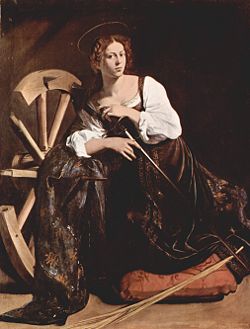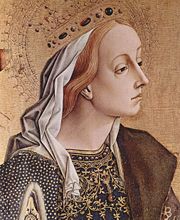Catherine of Alexandria
| Saint Catherine of Alexandria | |
|---|---|
 Saint Catherine of Alexandria by Caravaggio, c. 1598 |
|
| Martyr and Virgin | |
| Born | c. 282, Alexandria, Egypt[1] |
| Died | c. 305, Alexandria, Egypt[2] |
| Venerated in | Roman Catholic Church Eastern Orthodox Churches Oriental Orthodox Churches Anglican Communion |
| Major shrine | Saint Catherine's Monastery, Mount Sinai |
| Feast | November 25 November 24 (Orthodox churches of Russian background) |
| Attributes | the "breaking wheel"; sword; with a crown at her feet; hailstones; bridal veil and ring; dove; scourge; book; woman arguing with pagan philosophers[3] |
| Patronage | Aalsum, apologists, craftsmen who work with a wheel (potters, spinners, etc.), archivists, dying people, educators, girls, jurists, knife sharpeners, lawyers, librarians, libraries, Balliol College, maidens, mechanics, millers, milliners, hat-makers, nurses, philosophers, preachers, scholars, schoolchildren, scribes, secretaries, spinsters, stenographers, students, tanners, teachers, theologians, University of Paris, unmarried girls, haberdashers, wheelwrights, Żejtun, Żurrieq[2][3] |
Saint Catherine of Alexandria, also known as Saint Catherine of the Wheel and The Great Martyr Saint Catherine (Greek ἡ Ἁγία Αἰκατερίνη ἡ Μεγαλομάρτυς) is a Christian saint and martyr who is claimed to have been a noted scholar in the early 4th century. In the beginning of the fifteenth century, it was rumored that she had spoken to Saint Joan of Arc. The Orthodox Churches venerate her as a "great martyr," and in the Catholic Church she is traditionally revered as one of the Fourteen Holy Helpers.
What is told of Saint Catherine's life is mostly composed of legends which have many different variations, and have little historical basis. The most popular version is that Catherine was the daughter of Costus, governor of Alexandria. She announced to her parents that she would only marry someone who surpassed her in everything, such that "His beauty was more radiant than the shining of the sun, His wisdom governed all creation, His riches were spread throughout all the world."[1]
Having received a vision that urged her to baptism, Catherine became a Christian and was transported to heaven in vision and betrothed to Christ by the Virgin Mary.
Contents |
Life and legend
She is said to have visited her contemporary Roman Emperor Maxentius and to have attempted to convince him of the error of his ways in persecuting Christians. She succeeded in converting his wife, the Empress, and many pagan wise men whom the Emperor sent to dispute with her, all of whom were subsequently martyred.[1] Upon the failure of the Emperor to win Catherine over, he ordered her to be put in prison; and when the people who visited her converted, she was condemned to death on the breaking wheel (an instrument of torture). According to legend, the wheel itself broke when she touched it, so she was beheaded.
In an elaboration of the legend, angels carried her body to Mount Sinai, where in the 6th century, the Eastern Emperor Justinian established Saint Catherine's Monastery, Mount Sinai, the church being built between 548 and 565. Saint Catherine's Monastery survives, a famous repository of early Christian art, architecture and illuminated manuscripts.
Her principal symbol is the spiked wheel, which has become known as the Catherine wheel, and her feast day is celebrated on 25 November by most Christian churches. However, the Russian Orthodox Church celebrates it on 24 November, because Empress Catherine the Great did not wish to share her patronal feast with the Leavetaking of the feast of the Presentation of the Theotokos. Because she was Catherine the Great's patron, the Catholic Church of St. Catherine, one of the first Catholic churches built in Russia, was named after Catherine of Alexandria.
Given the paucity of historical information, however, there is very little evidence to confirm any of these legends. Indeed, mentions of the legends themselves only began to appear centuries after her death.
History and veneration
Historians such as Harold Thayler Davis believe that Catherine ('the pure one') may not have existed and that she was more an ideal exemplary figure than a historical one.[4] She did certainly form an exemplary counterpart to the pagan philosopher Hypatia of Alexandria in the medieval mindset; and it has been suggested that she was invented specifically for that purpose. Like Hypatia, she is said to have been highly learned (in philosophy and theology), very beautiful, sexually pure, and to have been brutally murdered for publicly stating her beliefs. Catherine is placed 105 years before Hypatia's death, although the first records mentioning her are much later.

Because of the fabulous character of her hagiography (the account of her martyrdom) and because of uncertainty about who she was, the Roman Catholic Church in 1969 removed her feast day from the Roman Catholic calendar of saints to be commemorated universally, wherever the Roman Rite is celebrated.[5] But she continued to be recognized as a saint of the Catholic Church, with a feast on November 25.[6] In 2002, her feast was restored to the Roman Catholic calendar of saints as an optional memorial, which may be celebrated throughout the Latin Church. The 1908 Catholic Encyclopedia describes the historical importance of the belief in her as follows:
Ranked with St Margaret and St Barbara as one of the fourteen most helpful saints in heaven, she was unceasingly praised by preachers and sung by poets. It is believed that Jacques-Benigne Bossuet dedicated to her one of his most beautiful panegyrics and that Adam of St. Victor wrote a magnificent poem in her honour: Vox Sonora nostri chori, etc.
In many places her feast was celebrated with the utmost solemnity, servile work being suppressed and the devotions being attended by great numbers of people. In several dioceses of France it was observed as a Holy Day of Obligation up to the beginning of the seventeenth century, the splendor of its ceremonial eclipsing that of the feasts of some of the Apostles. Numberless chapels were placed under her patronage and her statue was found in nearly all churches, representing her according to medieval iconography with a wheel, her instrument of torture. Meanwhile, owing to several circumstances in his life, Saint Nicholas of Myra was considered the patron of young bachelors and students, and Saint Catherine became the patroness of young maidens and female students. Looked upon as the holiest and most illustrious of the virgins of Christ after the Blessed Virgin Mary, it was natural that she, of all others, should be worthy to watch over the virgins of the cloister and the young women of the world. The spiked wheel having become emblematic of the saint, wheelwrights and mechanics placed themselves under her patronage. Finally, as according to tradition, she not only remained a virgin by governing her passions and conquered her executioners by wearying their patience, but triumphed in science by closing the mouths of sophists, her intercession was implored by theologians, apologists, pulpit orators, and philosophers. Before studying, writing, or preaching, they besought her to illumine their minds, guide their pens, and impart eloquence to their words. This devotion to St. Catherine which assumed such vast proportions in Europe after the Crusades, received additional éclat in France in the beginning of the fifteenth century, when it was rumored that she had spoken to Joan of Arc and, together with St. Margaret, had been divinely appointed Joan's adviser. The Mystical Marriage of Saint Catherine of Alexandria by Giuseppe Ribera, 1648. Catherine kisses an infant Jesus, who is held by the Virgin Mary. In the background are Saint Anne and Saint Joseph.
The Mystical Marriage of Saint Catherine of Alexandria by Giuseppe Ribera, 1648. Catherine kisses an infant Jesus, who is held by the Virgin Mary. In the background are Saint Anne and Saint Joseph.
References
- ↑ 1.0 1.1 1.2 Self-Ruled Antiochian Orthodox Christian Archdiocese of North America. Accessed 30 Dec 2006.
- ↑ 2.0 2.1 See her Patron Saints Index profile
- ↑ 3.0 3.1 See her Catholic Culture profile
- ↑ Harold Thayler Davis. Alexandria: The Golden City. (Principia Press of Illinois, 1957).
- ↑ Calendarium Romanum (Libreria Editrice Vaticana, 1969), p. 147
- ↑ Martyrologium Romanum (Libreria Editrice Vaticana, 2001 ISBN 88-209-7210-7)
This article incorporates text from the public-domain Catholic Encyclopedia of 1913.
Gallery
See also
- Catherinettes
- Catherine wheel
- Saint Catherine of Alexandria, by Raphael
- Saint Catherine, by Caravaggio
- Catharina - Lunar crater named after St. Catherine
- Saint Catherine's Monastery, Mount Sinai
- Santa Catalina Island - California Channel Island named after St. Catherine
- Santa Catalina Mountains - A prominent mountain range north of Tucson, Arizona, United States was named after St. Catherine in 1697.
- Se Cathedral - dedicated to Saint Catherine
- Cartagena de Indias - Main colombian city which Saint Catherine is patron.
- Santa Catarina - One of the tree states in south Brazil.
- St. Catherine Band Club [1]
External links
- Iconographical Themes in Art - Saint Catherine of Alexandria
- Details of Saint Catherine's life - Saint Katherine Orthodox Church; includes a gallery of icons of the saint
- Feast of the Holy Great Martyr and Most Wise Katherine of Alexandria - Greek Orthodox Archdiocese
- St Catherine's church in Muhu island (Estonia)
|
|||||